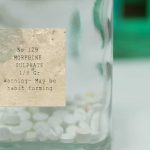In Greek mythology, Morpheus was a god of dreams and a son of Somnus, the god of sleep. It’s fitting that morphine, the earliest opioid painkiller and narcotic drug isolated by humanity, takes its name from a figure so closely associated with slumber and sedation.
Where Morphine Comes From
Papaver somniferum, the opium poppy or breadseed poppy, is a flowering plant grown in many areas of Europe and Asia. It produces edible poppy seeds as well as natural organic substances that can be processed and used for pain relief.
Opium is the most abundant of these substances. Its usefulness in treating pain is why the opium poppy plant and opium have been used by so many different cultures stretching back into prehistory.
In fact, widespread use of opium as a painkiller and medical cure-all only ended when morphine (an opiate and the active ingredient of opium) was isolated by a German pharmacist named Friedrich Sertürner in the early 1800s.
This allowed the purified drug to be made available for international distribution by 1827.
Morphine/Opium Harvest
Depending on who is producing opium and for what reason, opium and morphine may be harvested in one of two common ways.
Illicit Opium
The opium is collected with fine slits made on young poppy bulbs, causing them to leak a white-colored natural liquid latex known as poppy tears. These “tears” dry down to a brown resin, or the opium itself.
Legal Opium
With legal opium production, the entirety of the upper poppy plant is harvested, mashed, and stewed in a dilute acidic solution. The alkaloid compounds are recovered and purified after, which is a system known as the Robertson-Gregory process.
How Morphine Is Produced
The mixture extracted from poppy plants contains morphine as well as other substances like codeine (a weak opioid painkiller) and thebaine. Thebaine is used to create derivative opioid drugs like hydrocodone, hydromorphone, oxycodone/OxyContin, oxymorphone, nalbuphine, naloxone, and buprenorphine.
After being collected, the compounds taken from opium are transported to pharmaceutical laboratories where they can be separated out, processed, and converted into different formulations for regular medical use.
Raw opium may also be diverted to black-market laboratories where morphine is extracted and converted into the illicit opioid drug diacetylmorphine, better known as heroin.
Heroin is more powerful and addictive than morphine and commands a higher price when smuggled across international borders for sale.
Morphine Brand Names
Medical morphine is produced in various forms including immediate-release and extended-release oral tablets and capsules, suppositories, intramuscular injections, intravenous injections, and subcutaneous injections.
Common brand name medications containing morphine include:
- AVINza
- Kadian
- Kadian ER
- Morphabond
- MS Contin
- Oramorph SR
- Roxanol
- Roxanol-T
- Embeda (morphine sulfate and naltrexone hydrochloride)
Morphine Uses
Morphine is a powerful short-acting opioid drug that is used to treat both moderate pain and severe pain, as well as chronic pain through the use of extended-release formulations.
It does this by binding to opioid receptors in the brain, spinal cord, and other areas of the body, and changing how your nerves respond to pain.
Morphine slows central nervous system activity (including thinking, blood pressure, heart rate, and breathing) while temporarily reducing feelings of stress, pain, fear, and anxiety.
While there are a number of powerful opioid analgesics, morphine’s predictability, varied formulations, and potency make it a medication of choice for pain related to heart attacks, cancer treatment, serious accidents, and battlefield injuries.
Risks Of Morphine Abuse
Besides analgesia, morphine is also known to cause several common side effects including drowsiness, dizziness, constipation, nausea, and sweating. Severe side effects should be referred to your doctor immediately.
The FDA and DEA have jointly scheduled morphine as a schedule II controlled substance. This means that while morphine has valid and key medical uses, it is also associated with high addictive potential.
Addiction & Dependence
Substance abuse involving morphine can result in severe psychological addiction and/or physical dependence.
Dependence, involving both tolerance and withdrawal symptoms after discontinuation, can also develop after long-term therapeutic use, and the drug should not be discontinued suddenly without medical advice.
If you or a loved one are struggling with opioid addiction, please call Northeast Addictions Treatment Center today.
Sources
Written by
Northeast Addition Editorial Team
©2024 Northeast Addition Center | All Rights Reserved
This page does not provide medical advice.




